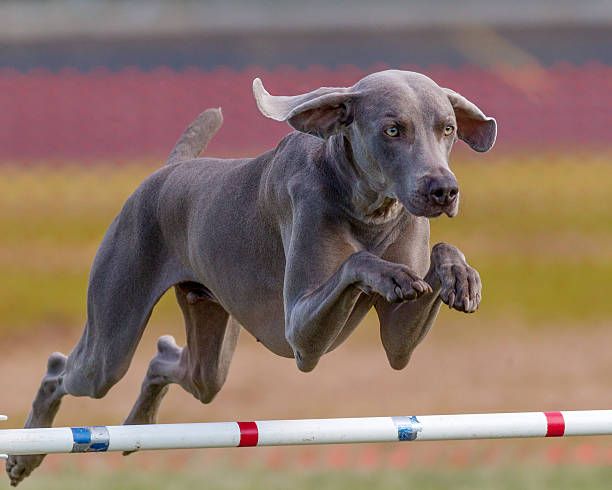Origin History of the Weimaraner:
The origin of the Weimaraner dates back to the early 19th century when they were developed at the Weimar court in what is now Germany. The noblemen there wanted a dog with courage, intelligence, good scenting ability, speed, and stamina to accompany them on their hunts. How they achieved their dream dog, first known as the Weimar Pointer, is unknown, but it’s believed that the breeds used to create the Weimaraner included the Bloodhound, the English Pointer, the German Shorthaired Pointer, the blue Great Dane, and the silver-gray Huehnerhund, or chicken dog.
As the decades passed, Germany’s forests shrank and big game became scarce. The Weimaraner’s handlers turned the breed’s talents to hunt birds, rabbits, and foxes. In 1897, an exclusive club was started in Germany to maintain the breed and ensure that responsible breeders would oversee its development. No one was allowed to buy a Weimaraner unless they joined the club. Strict guidelines were imposed upon the breeding of Weimaraners.
In 1929, Howard Knight, an American sportsman, was allowed to join the German club and bring two Weimaraner dogs to the U.S. The Germans were so protective of their “Gray Ghosts” that although Knight promised he would protect the purity of the breed, the club sent him two desexed dogs. Knight was not deterred, however. He kept working to get some foundation dogs that he could breed in the U.S.
Finally, in 1938, he acquired three females and a male puppy. The females included two littermates, Adda and Dorle v. Schwarzen Kamp, and a year-old female named Aura v. Gailberg. The male puppy was named Mars aus der Wulfsreide. Other breeders joined Knight in his quest to breed Weimaraners in the U.S. and in 1942, the Weimaraner Club of America was formed.

The American Kennel Club recognized the breed at the end of 1942. The breed made its formal show debut at the Westminster Kennel Club show in 1943. During World War II, it became difficult for German breeders to keep their dogs, so many outstanding Weimaraners were sent to the U.S. At the end of World War II, many American servicemen brought Weimaraners home with them, and they quickly grew in popularity, especially when President Dwight D. Eisenhower brought his Weimaraner, Heidi, to the White House. By the mid-to-late 1950s, Weimaraners were the 12th most popular breed registered by the AKC.
Weimaraner Appearance:
The physical appearance of the Weimaraner has often been described as regal, strong, and graceful. They have sleek, muscular bodies with deep chests and relatively long legs. The breed has a unique, striking silver-gray coat that can range from mouse-gray to silver-gray, with lighter shades on the head and ears. Weimaraners have a distinctively long muzzle, dark gray nose, and deep-set eyes that can be amber, blue, or gray.
Their ears are long and hang low, framing the face, and the coat is short and smooth. Weimaraners have a distinctively long tail that tapers to a point, and the paws are large and round. The overall look of the Weimaraner is nothing short of majestic.
Diet and Nutrition:
Weimaraners are large, active dogs that need a diet that matches their energy levels. As a result, high-quality dry food is the best choice for these dogs, as it is nutrient-dense and can provide them with the nutrition they need. It is recommended to feed Weimaraners 2.5 to 3.5 cups of high-quality dry food per day, divided into two meals. This amount should be adjusted based on the individual dog’s size, age, metabolism, and activity level. Because Weimaraners are prone to obesity, it is important to measure out the food and not leave it out all day.
In addition to a healthy diet, Weimaraners should also have access to plenty of fresh water throughout the day and regular exercise. Aim for at least two 30-minute walks a day, as well as some playtime in the yard or a nearby park. Food-motivated activities, such as snuffle mats or filled toys, can help engage their active minds and challenge them mentally. Low-calorie treats like sweet potatoes are also a good choice for training and rewarding good behavior.
Overall, the diet and nutrition needs of Weimaraners should be tailored to the individual dog’s size, age, metabolism, and activity level. It is important to consult your veterinarian to determine the best food to feed your pup, as all dogs have different dietary requirements. With the right diet and plenty of exercise, your Weimaraner will be able to stay healthy and happy.

Common Health Issues Affecting Weimaraners:
Weimaraners are generally healthy dogs, but like all breeds, they are prone to certain health conditions. Common health issues affecting Weimaraners include hip and elbow dysplasia, hypothyroidism, von Willebrand’s disease, thrombopathia, and eye problems.
- Hip dysplasia is an abnormality of the hip joint that can cause pain and lameness.
- Elbow dysplasia is a condition that causes pain in the elbow joint due to an abnormality of the growth plates.
- Hypothyroidism is a common metabolic disorder that can cause lethargy, weight gain, and skin problems.
- Von Willebrand’s disease is a disorder of the blood that affects clotting and can lead to excessive bleeding.
- Thrombopathia is a rare genetic condition that can cause clotting problems and may lead to strokes or heart attacks.
- Eye problems such as progressive retinal atrophy and cataracts can also occur in Weimaraners.
It is important to work with a reputable breeder to ensure your puppy has been tested for these conditions and is clear of any genetic health issues. Regular veterinary checkups are also important to help detect any potential health issues early.

Interesting Facts About Weimaraners:
One interesting fact about Weimaraners is that they were originally bred to be versatile hunting dogs. This means that they have incredible endurance, speed, and agility. They can also smell their prey from a great distance and can even track their prey in the dark. This makes them ideal for tracking game such as deer, bears, and wolves.
Another interesting fact about Weimaraners is that they are known as the ‘Gray Ghost’ due to their distinctive gray coat and light-colored eyes. They are also incredibly intelligent and can often learn commands and tricks quickly. They are also very loyal and devoted to their owners and love to be around people.
Finally, Weimaraners are also known for their unique facial expressions. This is because they have long facial muscles that can be used to mimic human expressions. They are often photographed with wigs, costumes, and props to capture these expressions. This has made them incredibly popular for photographs, calendars, and books.
Where to Adopt or Buy:
If you’re looking to adopt or buy a Weimaraner, there are a few routes you can take. The first is to look for a rescue group that specializes in Weimaraners. Organizations like Weimaraner Rescue of Texas, Weimaraner Rescue of the South, and Weimaraner Rescue of Wisconsin are just a few of the groups that exist to help Weimaraners find their forever homes.
Another option is to look for a breeder who specializes in Weimaraners. Before buying from a breeder, make sure to research them thoroughly and visit them in person to ensure they are reputable and ethical. Lastly, there are also Weimaraners available for adoption through your local animal shelter. No matter which route you decide to take, make sure to do your research and be prepared to commit to the responsibility of owning a Weimaraner.

Conclusion:
The Weimaraner is a unique breed of dog that has a very loyal and devoted personality. They are highly intelligent and have an independent spirit, making them an ideal companion for a family with an active lifestyle. With their beautiful silvery-gray coat and light amber, blue-gray, or gray eyes, they are often referred to as the “Silver Ghost” or “Gray Ghost”. They are also known for their strong prey drive and need regular exercise and mental stimulation to ensure they don’t become high-strung and nervous.
Weimaraners are highly social dogs and need plenty of human interaction and companionship. They are not suited to living in a kennel or being kept in the backyard with little human interaction. It is important to provide them with early socialization and obedience training to ensure that they remain well-rounded and friendly. With the right amount of exercise, socialization, and training, the Weimaraner can become an excellent family companion and watchdog.
In conclusion, the Weimaraner is an intelligent and loyal breed of dog that needs an active lifestyle and plenty of human interaction. They are not suited to kennel life or backyard living and need regular exercise, socialization, and training to stay healthy and happy. If you are looking for an intelligent, loyal, and active companion, the Weimaraner may be the perfect breed for you.
FAQ:
Q: How much exercise does a Weimaraner typically need?
A: Weimaraners are an active breed and need plenty of daily exercise to stay healthy and happy. This can include long walks, running, swimming, playing fetch, and other activities that challenge their minds and bodies. They should have at least an hour of vigorous exercise every day, but more is better.
Q: What type of diet should I feed my Weimaraner?
A: Weimaraners are prone to weight gain, so it’s important to feed them a high-quality diet that is appropriate for their age and energy level. Look for a diet that is balanced and contains plenty of lean proteins, complex carbohydrates, and healthy fats. Avoid foods that are high in sugar, fillers, and preservatives.
Q: How much grooming will my Weimaraner need?
A: Weimaraners require minimal grooming – their short coats are easy to maintain. Brush them once or twice a week with a bristle brush to remove loose hairs and keep their coats healthy. They may also need their nails trimmed once or twice a month if they don’t wear them down naturally.
Q: Are Weimaraners good with children?
A: Weimaraners can be good with children, but they should always be supervised. Weimaraners have a lot of energy and can be boisterous, so they may not be the best choice for younger children or those who are easily overwhelmed.
























